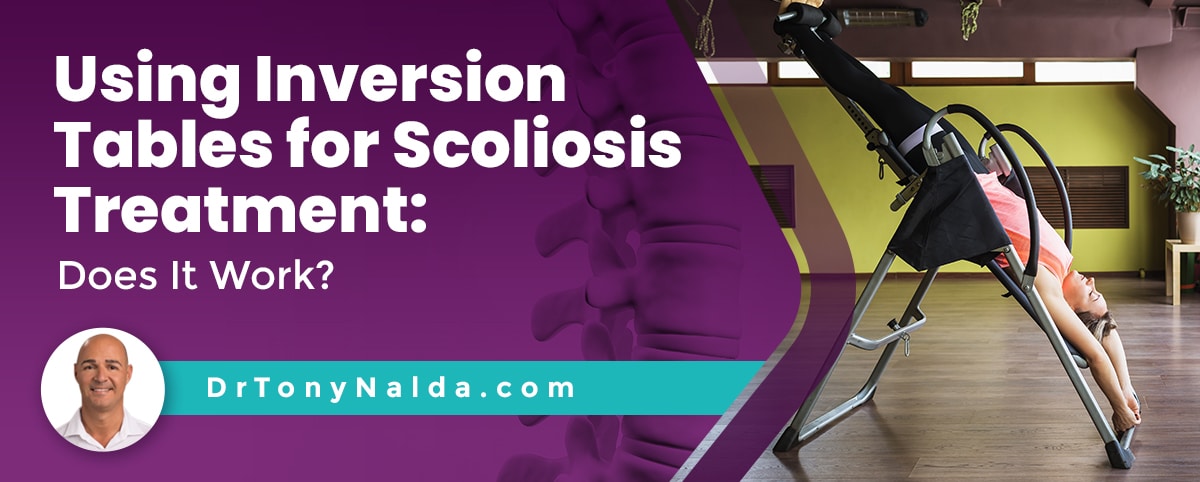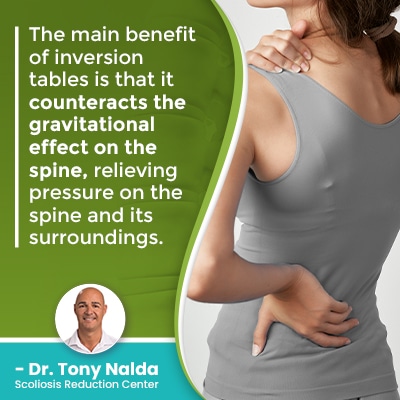Using Inversion Tables for Scoliosis Treatment: Does It Work?

Inversion therapy addresses a number of spinal issues related to compression of the spine and its surrounding muscles and nerves; however, for scoliosis patients, its effects are more indirect. While the use of an inversion table can help with short-term pain relief, it can't address the underlying cause of scoliosis by impacting it structurally, so is more accurately associated with certain therapeutic benefits, than with treatment efficacy.
Inversion therapy involves the body being held upside down, or at an inverted angle. Adult scoliosis is a compressive condition, and inversion tables can reverse the gravitational pressure on the spine, reducing compression; however, it doesn't have the power to impact scoliosis structurally.
As is always the case, no form of therapy and/or treatment, inversion therapy included, should be applied before a patient gets it cleared by their scoliosis treatment provider.
Table of Contents
What is Inversion Therapy?
Before getting to the specifics of inversion therapy and scoliosis treatment, let's first explore the methodology and concept behind the use of inversion tables.
Inversion therapy is based on the theory that reversing the gravitational pressure on the body removes/reduces the effects of uneven forces (compression) causing bones, joints, and muscles in the back to contribute to spinal compression.
Being inverted simulates the lengthening motion a growing spine experiences, which is why scoliosis doesn't become compressive until adulthood.
Allowing the spine to fully stretch increases the space between vertebrae (bones of the spine), the intervertebral discs that sit between adjacent vertebrae, and takes pressure off the back in general, including its surrounding muscles, nerves, nerve roots, and vessels.
A lot of back-related pain is caused by compression and stiffness.
Scoliosis is progressive, meaning it will get worse over time, particularly if left untreated, or not treated proactively, and as the condition progresses, this means the unnatural spinal curve is increasing in size, and the spine is becoming more and more rigid; this also causes the spine's surrounding muscles to become strained, sore, tight, and painful as a result.
The lengthening motion achieved through inversion can involve handstands, hanging upside down from a bar with gravity boots, or an inversion table.
How Does Inversion Therapy Affect the Spine?
 By using the body's own weight to counteract gravity, it can help decompress the body's joints, including the spinal joints.
By using the body's own weight to counteract gravity, it can help decompress the body's joints, including the spinal joints.
The principle of spinal traction guides inversion therapy as stretching the spine can bring pain relief to a variety of back pain causes; however, this type of pain relief will only be short term relief as when the body returns to its upright position, the spine is, once again, subject to the effects of gravity/compression.
Also, being inverted for long periods of time should be approached with caution by those with slow heart rates, as the heartbeat slows considerably, and/or those with high blood pressure.
Inversion therapy that uses gravity boots, allowing patients to hang from their feet, allows the spinal joints to be loaded equally, while in direct opposition to their usual location when in the standard upright position of spinal alignment.
The effect of stretching the spine is a benefit of using an inversion table as it temporarily creates more space between the vertebrae and spinal discs, which in a healthy spine are stacked on top of one another in a straight and neutral alignment.
The spinal discs don't have their own vascular supply, so the therapeutic benefits of replenishing the discs through increasing their space and blood flow is helping them replenish, and this increases spinal flexibility, making the spine more responsive to being manipulated through chiropractic care.
Now that we've explored the methodology and concept behind the use of inversion tables and inversion therapy, let's explore its place in scoliosis treatment.
Adult Scoliosis Treatment and Inversion Therapy
Being diagnosed with scoliosis means an unnatural sideways spinal curve has developed, with rotation, making it a 3-dimensional condition, and a minimum Cobb angle of 10 degrees.
Cobb angle is a measurement taken during X-ray that classifies scoliosis in terms of severity; the higher the Cobb angle, the more severe the condition: mild, moderate, severe, or very severe.
As scoliosis develops, the spine's vertebrae become misaligned, and as a progressive condition, if left untreated, the curve gets larger, the spine becomes more misaligned, and this commonly causes postural changes, and pain (in adults).
The reason inversion therapy and inversion tables are more commonly used in adult scoliosis is because of skeletal maturity, gravity, and compression.
In young patients with idiopathic scoliosis who are still growing, their spines are experiencing a constant lengthening motion, and this counteracts the compressive force of the unnatural spinal curve, reducing its effects on the spine and its discs, surrounding muscles, and nerves.
Adults however, for whom scoliosis is compressive, experience pain very differently, which is why pain relief is often a focus of treating scoliosis in adults, and why inversion therapy can bring temporary pain relief for adults, but only for small amounts of time.
When used appropriately, to augment forms of corrective treatment that can impact the condition structurally, inversion therapy is an alternative treatment that can help achieve pain relief, core strengthening, and posture correction in adult scoliosis patients.
Pain Relief
In patients who have reached skeletal maturity, their spines have settled due to gravity and maturity, making the condition compressive, and this is felt by the spine, the spinal discs, surrounding muscles, vessels, and nerves.
The reason inversion therapy isn't commonly used in the treatment of adolescent scoliosis is because its pain-relief benefits are often unnecessary; scoliosis doesn't become a compressive condition until adulthood.
 The main benefit of inversion tables is that it counteracts the gravitational effect on the spine, relieving pressure on the spine and its surroundings.
The main benefit of inversion tables is that it counteracts the gravitational effect on the spine, relieving pressure on the spine and its surroundings.
When pressure is reduced/removed, it can provide short term relief from pain caused by compression, tight muscles, spinal misalignments, facet syndrome, and more, but what happens when the inversion therapy is over?
While inversion tables work for short-term pain relief, they don't provide a long-term solution as when the inversion is reversed and the body returns to its regular upright position, the spine settles once again, and is subject to the compressive force of the condition.
Only treatment that impacts scoliosis on a structural level addresses the underlying cause of pain: the condition's structural nature.
Long-term relief from scoliosis pain can be achieved through proactive treatment that, first and foremost, impacts the condition on a structural level: through scoliosis-specific chiropractic care.
In addition to short-term pain relief for adults, when used in conjunction with other forms of corrective treatment, inversion therapy is associated with some additional benefits.
Core Strengthening
Among the potential benefits of inversion therapy for the treatment of adult scoliosis is core strengthening.
After all, it's not just the spine that's in charge of maintaining its natural curves and alignment, but also its surrounding muscles that provide it with support and stabilization.
Inversion tables are associated with increasing abdominal muscles by performing certain exercises while engaging the core and targeting the spinal muscles.
Remember, however, that increasing core strength is only one facet of scoliosis treatment, and on its own, can't impact scoliosis on a structural level, or address a misaligned spine.
In addition to temporary pain relief and abdominal strengthening, inversion therapy can also help with posture correction.
Postural Remodeling
There is a school of thought that inversion therapy, and in particular, the use of inversion tables, can help correct poor posture: known to improve overall spinal health and biomechanics.
As a scoliotic spine is stretched and relieved from the uneven forces, scoliosis introduces to the body, increased blood flow to multiple areas of the back can also help provide relief from back spasms.
Increased blood circulation can be particularly helpful to the spinal discs, which can degenerate with age and certain lifestyle choices such as carrying excess weight and chronic poor posture.
The spinal discs are key to optimal spinal health as they combine forces to facilitate spinal flexibility, provide cushioning between adjacent vertebrae, structure (vertebrae attach to the disc in between), and act as the spine's shock absorbers: all necessary for spinal alignment.
So inversion therapy can help increase blood flow, benefiting the spine's intervertebral discs and the musculoskeletal system as a whole, but scoliosis isn't caused by weak muscles and/or poor posture alone, nor can it be treated by inversion therapy alone.
Conclusion
As a complex structural spinal condition, scoliosis necessitates the customization of effective treatment plans via the integration of multiple forms of treatment so conditions can be impacted on every level.
So do inversion tables work for scoliosis patients? If used to augment structural changes achieved through chiropractic care, in-office therapy, corrective bracing, and custom-prescribed home exercises, it can have a place in providing short-term pain relief and general therapeutic benefits for adults; however, there is very little data/research supporting a clear connection between inversion therapy, sustainable long term relief, and scoliosis treatment success.
While some report inversion machine benefits, particularly in combination with physical therapy, experts emphasize that minimally invasive spine surgery may be more effective for conditions like scoliosis, with some healthcare professionals cautious to recommend inversion therapy as a primary treatment.
The benefits of inversion therapy include counteracting the gravitational force on the spine and its surroundings, which is known to cause compression-related pain.
The stretching benefit of spinal traction includes keeping the spine and its surrounding muscles as loose and flexible as possible, but these benefits are short-lived, as when the body is no longer inverted, gravitational pressure and compression will return.
The only effective means of achieving long-term sustainable pain relief is through proactive treatment that addresses the underlying cause of pain: the condition's structural nature.
Here at the Scoliosis Reduction Center, my chiropractic-centered treatment approach integrates multiple forms of scoliosis treatment so patients can experience the potential benefits of inversion therapy and more: a long-term solution for pain caused by scoliosis, core strengthening, posture correction, and curvature reductions on a structural level.
Dr. Tony Nalda
DOCTOR OF CHIROPRACTIC
After receiving an undergraduate degree in psychology and his Doctorate of Chiropractic from Life University, Dr. Nalda settled in Celebration, Florida and proceeded to build one of Central Florida’s most successful chiropractic clinics.
His experience with patients suffering from scoliosis, and the confusion and frustration they faced, led him to seek a specialty in scoliosis care. In 2006 he completed his Intensive Care Certification from CLEAR Institute, a leading scoliosis educational and certification center.
About Dr. Tony Nalda
 Ready to explore scoliosis treatment? Contact Us Now
Ready to explore scoliosis treatment? Contact Us Now





